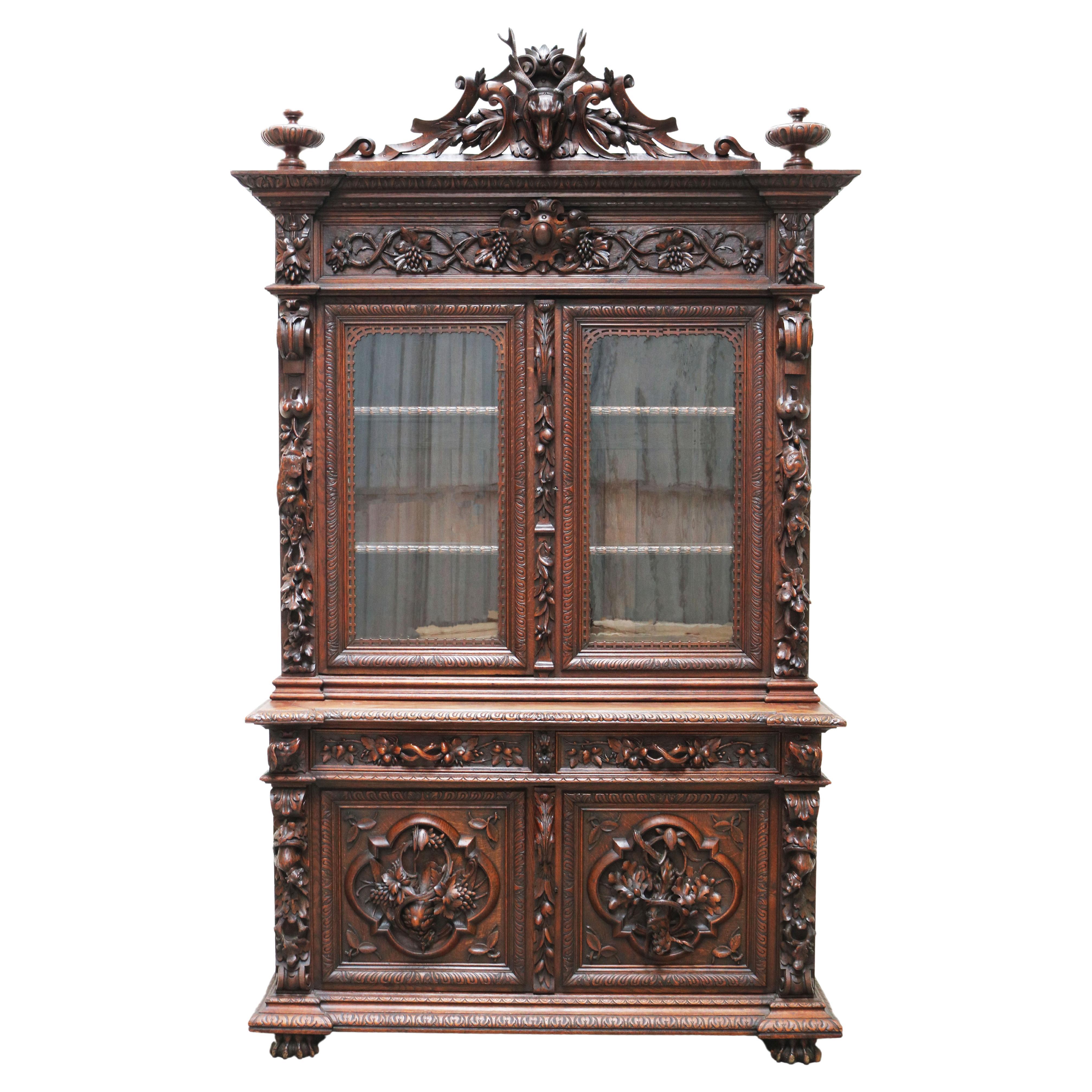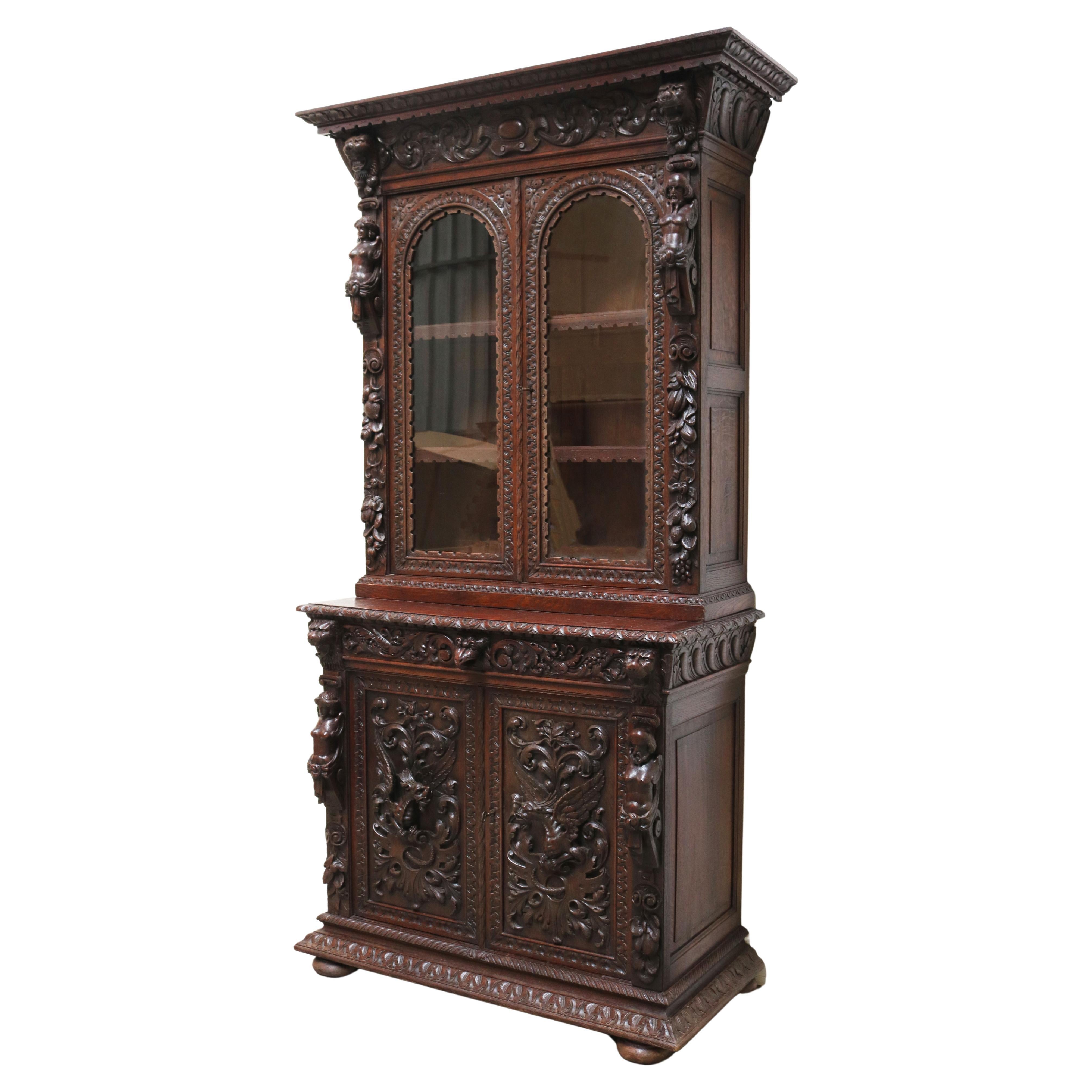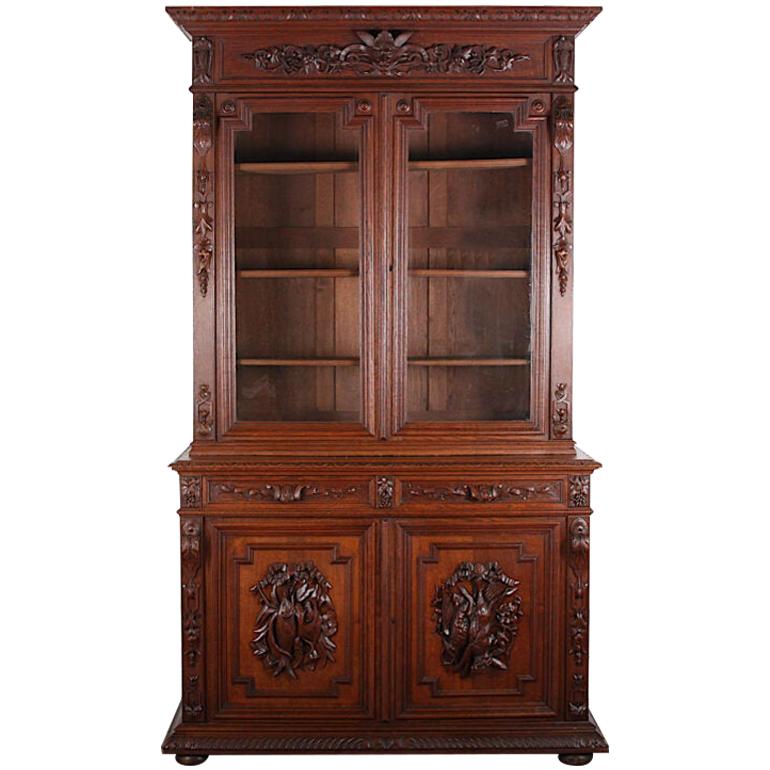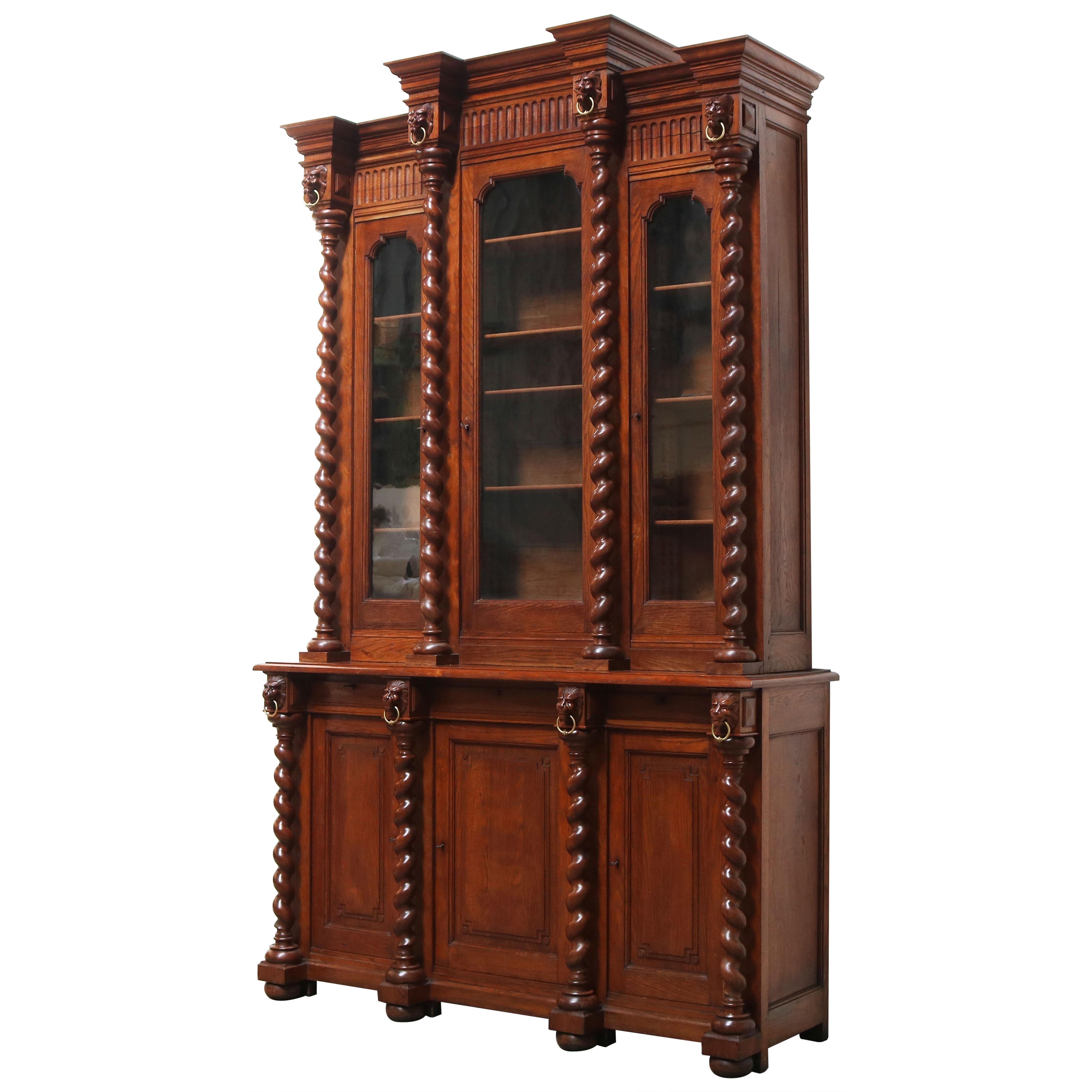Items Similar to Neo-Renaissance style cabinet with painted enamels signed by Theophile Soyer
Want more images or videos?
Request additional images or videos from the seller
1 of 19
Neo-Renaissance style cabinet with painted enamels signed by Theophile Soyer
About the Item
This two-bodies Neo-Renaissance style display cabinet with two glass doors was made in the second half of the nineteenth century in waxed walnut. The enamel plates, remarkable in their execution, are signed with the initials of Theophile Soyer (1853-1940), great enameler of the second half of the 19th century. Enamels in black and white hues, which suggest an early work as they are far different from the better-known production of Theophile Soyer , as well as the cabinet making work, allow to date it more precisely from the years 1875- 1880.
In the middle of the cabinet, on the main panels, two oval bulging medallions represent on one side “Apollo slaying the Python”, on the other “Diana the Huntress”. Apollo, a quiver on his back, arrow in the hand and with a triumphant glare, spans a dead snake on the ground, while Diana is represented with her traditional attributes: a quiver and a dog at her side, the goddess with knotted hair and uncovered breast is preparing, with a certain nonchalance, to loose an arrow. The two medallions are set in carved frames adorned with bouquets of flowers, lions and friezes of pearls. On the doors of the lower cupboards, four panels adorned with rectangular enamel plates, also signed Theophile Soyer , represent the seasons incarnated by putti. While spring is symbolized by the rebirth of Flora, summer prepares winter by the harvesting of ears of wheat. Autumn is the season of grape harvest: the putto holds in one of his hands the fruits of his crop and in the other a cup that will host the drink. In winter, the putto is covered with a drapery moving in the fresh air of the wind. The enamels are made with great virtuosity and adds to this piece of furniture a great preciousness. The square and rectangular Black Marquina marble pieces that decorate this work are echoed by the enamels they only enhance. These enamels are indeed of a great brilliance and their figures of a brilliant whiteness contrast with the black background. The gold-colored elements, such as the quivers of the God and the Goddess, enhance the whole. The furniture is capped with an architected broken pediment whose cut sides are adorned with cornucopias from which spread pomgranates. In the center, on a pedestal, stands a bronze statue made by the Barbedienne foundry representing Lorenzo II de Medici, Duke of Urbino (1492-1519), sitting and thoughtful. It is a representation of the statue decorating the tomb of the latter made by Michelangelo in the sixteenth century inside the Medici Chapels in Florence. This statue will have a great fortune in the nineteenth century through many editions. On either side of the central cupboard, two faun-looking Atlants were carved with great finesse and great attention to detail. Their bust, depicting the features of an aging body, rests on a pedestal and their bearded face is capped with an oriental-inspired turban. These two enigmatic and mysterious figures are typical of the Neo-Renaissance style and the very nineteen-ish taste for curiosities. In addition to bronzes, marble and enamels, it is remarkable to note the lavishness of the carved ornamental repertoire such as the curves and laurel branches on the pediment, the lion heads and baskets of fruits on the central doors, the few naturalist rosettes or even foliage carved around enamel plates with putti. The lavish decor of this furniture reflects a taste for detail that goes hand in hand with the Neo-Renaissance style, appeared in the 1830s in a context of rediscovering history and past styles. The cabinetmaking work of this firm, which can be said to be a Parisian work, is in fact characteristic of workshops production of the period specialized in the Neo-Renaissance style such as the Grohé brothers or the Damon, Namur et Cie house, such as this Neo-Renaissance style credenza carved in natural walnut on display at the 1878 World Fair. Like the one we present here, this credenza is composed of two glazed bodies making a library and connected by a chest opening with two doors. The furniture is also surmounted by a pediment where, between the arches, a pedestal is decorated with a bronze work of art reproducing the famous statue of Lorenzo II de Medici. Founded in 1840 by Antoine Krieger, then sold to M. Recault before being taken over by Damon, Namur et Cie, this house quickly acquired a certain importance and imposed itself on the French and European markets. The locks are marked “Huby fils serrurier Paris” (“Huby son locksmith Paris”). Auguste Luchet calls him in his account of the 1867 World Fair the “young prince of the locksmiths” and his Renaissance-style creations were famous.
Our piece of furniture takes its decor and theme in the Renaissance but also its technique. Painted enamel and carved wood are among the techniques that artists intend to put back into fashion, both by challenge and by the desire to perpetuate traditional and artisanal skills in a nineteenth century marked by industrialization and development. Painted enamel, which developed in Limoges from 1530 to the beginning of the 17th century, belongs in fact to the crafts of the Renaissance, until its consecration in the second half of the century, time of pastiches of all kinds. Reappeared around 1840, painted enamels were thus, from the 1860s, practiced by many artists. Among them, Paul Soyer , sculptor by profession and father of Theophile, was the collaborator, since 1863, of Claudius Popelin (1825-1892), painter and enameller thanks to whom the enamel painted “in the manner of Limoges” found a prominent place. Paul Soyer later created his own studio which enjoyed a certain success thanks to the decorations he created to adorn furniture and objects and specialized in enamel painted white figures on a black background like the enamels of the Renaissance. With this piece of furniture, Theophile Soyer , who will later be one of the great enamellers of the Art Nouveau style with a production in bright and shimmering colors, seems to be in line with the paternal style, at a time when he is still his collaborator. The work of this piece of furniture is therefore the fruit of a youthful work, which sets it apart from the usual production of Theophile Soyer .
Born in 1853 in Paris and died in 1940, Théophile Soyer began with his father who, according to Michel Dillange, was “more of a craftsman than an artist”, which led him to push his son to follow Fine Arts lessons in order to be the creator of ever more artistic compositions. After this training, where he learns the copy of the Olds, Theophile Soyer follows the courses of Yvon and Levasseur. He began to work with enamel in Courbevoie, then joined the workshop of his father rue Saint-Sauveur, workshop he resumed in 1896. He exhibited for the first time at the Salon of 1870 where he presented an enamel copy of a work by Elder Barber, Apollo killing the Python, a theme found on one of the plates adorning this piece of furniture. This concordance supports the realization of this piece of furniture and enamels in the years 1870-1880. He then exhibited regularly from 1875 to 1882 as well as in the Exhibitions of the Central Union of Fine Arts from 1876. He also received a silver medal at the 1889 World's Fair and a gold medal at the 1900's. In 1909, he moved to open a new workshop rue de Bondy where he remained until the end of the First World War. Theophile Soyer took an active part in the artistic life of his time: he was vice-president of the Union Chamber of Ceramics and Glass and President of the Society of Eclectics, a humorous society founded in 1872 by aquafortists and poets where he meets Dr. Gachet. He was the husband of Eugenie Dejoux, painter-enameler from Geneva, from which he will have a daughter, Jeanne, also destined to work with his parents before getting married in 1906. A certain technicality characterizes this piece of furniture and corresponds to the desire of the decorating artists of the time to reconnect with the arts and crafts. This piece of furniture, between an object of cabinet-making and an art object, is thus characteristic of the Neo-Renaissance style and the very nineteen-ish taste for past styles. Above all, it allows to appreciate the early, precious and sophisticated work of one of the greatest enamellers of the second half of the 19th century.
- Creator:Théophile Soyer (Artist)
- Dimensions:Height: 99.81 in (253.5 cm)Width: 88.59 in (225 cm)Depth: 22.84 in (58 cm)
- Style:Renaissance Revival (Of the Period)
- Materials and Techniques:
- Place of Origin:
- Period:
- Date of Manufacture:1860
- Condition:
- Seller Location:SAINT-OUEN-SUR-SEINE, FR
- Reference Number:
About the Seller
No Reviews Yet
Recognized Seller
These prestigious sellers are industry leaders and represent the highest echelon for item quality and design.
1stDibs seller since 2022
Typical response time: 9 hours
- ShippingRetrieving quote...Ships From: SAINT-OUEN-SUR-SEINE, France
- Return PolicyThis item cannot be returned.
More From This SellerView All
- Flemish Neo-Renaissance Style FireplaceLocated in SAINT-OUEN-SUR-SEINE, FRThis monumental fireplace was made in Belgian Petit Granit in the second half of the 19th century inspired by the Flemish Renaissance art answering the revival vogue of this period. ...Category
Antique Late 19th Century Belgian Renaissance Revival Fireplaces and Man...
MaterialsMarble, Bronze
- Neo-Renaissance Style Buffet from 19th Century, Richly CarvedBy Paul SoyerLocated in SAINT-OUEN-SUR-SEINE, FRThis large Neo-Renaissance style richly carved oak sideboard was made at the end of the 19th century. It is composed of three distinct parts, all decorated with numerous plant arabes...Category
Antique 19th Century French Renaissance Revival Buffets
MaterialsBronze, Enamel
- Cabinet in Walnut Molded and Carved with Enamelled Plates DecorationBy Henri Victor Lesur 1Located in SAINT-OUEN-SUR-SEINE, FRBeautiful Napoleon III style walnut cabinet, richly carved, made in the second half of the 19th century. The carved decoration is very detailed, refined, and of high quality. Five enamelled plates adorn the doors, apron and pediment of this cabinet. The enamels bear...Category
Antique 19th Century French Napoleon III Furniture
MaterialsEnamel
- Carved Walnut Neo-Renaissance Dining Room FurnitureLocated in SAINT-OUEN-SUR-SEINE, FR"Carved Walnut Dining Room Furniture In Neo-Renaissance Style" Dining room furniture consisting of a large sideboard, a server and eight chairs. In carved walnut, 19th century. The t...Category
Antique 19th Century French Gothic Dining Room Sets
MaterialsWood, Walnut
- Neo-Renaissance Period Stone Fireplace, Dated 1534Located in SAINT-OUEN-SUR-SEINE, FRThis outstanding Tonnerre stone fireplace is a masterpiece of the first French Renaissance. It was sculpted in 1534, under the reign of King François the 1st for Philippe Merlan (1503-1546), Baron of Montpont, Lord of Jully-lez-Arnay-le-Duc. This monumental fireplace...Category
Antique 16th Century French Renaissance Fireplaces and Mantels
MaterialsStone
- Turquin marble fireplace in neo-Gothic styleLocated in SAINT-OUEN-SUR-SEINE, FRTurquin marble fireplace in neo-Gothic styleThis Turquin Blue marble fireplace in neo-Gothic style was executed in the first half of the 19th cen...Category
Antique 1840s French Gothic Revival Fireplaces and Mantels
MaterialsMarble
You May Also Like
- 19th Century Renaissance Revival Oak Hand Carved Cabinet BookcaseLocated in Roma, RMAmazing carved cabinet, in two parts, doors above and drawers below. Late 19th century, Neo-Renaissance period, made of oak wood, fully decorated on all surfaces with fine carvings of scenes with characters and floral motifs. Inside the doors is the mark Created...Category
Antique 1870s Swedish Renaissance Revival Cabinets
MaterialsOak
- Rare Antique French Hunt Cabinet Renaissance Carved Oak Black Forest BookcaseLocated in Ijzendijke, NLExquisite & Breathtaking! This rare monumental 19th century French hunt style / renaissance revival Cabinet of exceptional quality. The cabinet is richly decorated with French hunt / Black Forest style carvings of numerous animals & floral decorations. All carved out of solid European oak by the hands of a master carver. Simply look at the close up pictures of the thick fully open carved panels for example: The dogs , Boar , acorns & branches. The large panels with Rabbit & Bird. And the large Stag sculpture on top. One of a kind masterfully carved Hunt cabinet...Category
Antique 1870s French Renaissance Revival Bookcases
MaterialsGlass, Oak
- Antique Italian 19th Century Renaissance Revival Bookcase / Display Cabinet OakLocated in Ijzendijke, NLExquisite & stunning! This rare 19th century Italian Renaissance Revival cabinet / bookcase / buffet in carved oak. The craftsmanship of the lion heads, angels & dragons is simply marvelous. Hand carved from oak and free carved out of the cabinet with open spaces. Breathtaking craftsmanship from a master carver. The most impressive are the 2 large dragons on the bottom their wings and heads come out of the door, marvelous details. High quality antique. The cabinet has 2 decorated adjustable shelves, a drawer & a bottom shelf. The cabinet has numerous renaissance decorations The top cabinet has: 2 lion masks, 2 angels male & female, rows of fruit / leaves & symmetrical renaissance style decorations The bottom cabinet has: 2 lion masks, gargoyle head drawer grip, 2 angels male & female. 2 large dragons and rows of fruit/leaves & symmetrical renaissance style decorations. A one of a kind antique that has a very practical size and will just keep impressing you with its details & craftsmanship day after day. This Italian renaissance cabinet...Category
Antique Mid-19th Century Italian Renaissance Revival Bookcases
MaterialsGlass, Oak
- 19th Century French Renaissance Revival Bookcase Cabinet Made of PineLocated in Dusseldorf, DEA 19th Century French bookcase in Renaissance style, made of solid pine. Consists of an upper and a lower part with a total of 4 doors. Facade-like front. Pilaster strips with flut...Category
Antique 19th Century French Renaissance Revival Bookcases
MaterialsFir, Pine
- 19th Century French Carved Oak Renaissance Revival Hunt Bookcase CabinetLocated in Vancouver, British ColumbiaImpressive French carved oak Renaissance-revival bookcase with finely-carve ‘hunt’ motifs to the lower doors below carved drawers, the top with a pair of glass doors...Category
Antique Late 19th Century French Renaissance Revival Bookcases
MaterialsOak
- Large Antique French Renaissance Bookcase Cabinet 19th Century Barley Twist OakLocated in Ijzendijke, NLOne of the most amazing pieces to ever leave our workshop! This French 19th century antique Renaissance Revival bookcase made out of solid European Oak. We are proud to offer this piece. The bookcase has 8 amazing hand carved lion heads (around the size of your hand) holding brass rings. And also 8 massive barley twist columns that give the bookcase a real luxurious & impressive look/feeling. The front , sides , back & shelves (entire bookcase) fully made out of solid European Oak. All details: Lions , barley twist , decorations have been hand-carved by a master carver , the quality and attention to detail are just exquisite ! When you stand before this cabinet and look up to it , it just grabs your attention and impresses you time and time again. We hope our video can provide you with an accurate feeling of its scale & size. Fully treated with antique wax & re-polished. all 9 original locks have been restored and are in perfect working order. All 8 lion rings have been re-polished by hand and look stunning. The cabinet has all its original 19th century antique glass windows...Category
Antique 1880s French Renaissance Revival Bookcases
MaterialsBrass
Recently Viewed
View AllMore Ways To Browse
Bronze Walnut Credenza
Lion And Snake Bronze
Dior Turban White
Walnut Credenza 1900
Antique Barber Cabinet
Antique Barbers Cabinet
Office Furniture Set Credenza
Antique French Harvest Baskets
Antique Oriental Statues
Craftsman Style Doors
Levasseur Bronze
1940s French Chest
Arts And Crafts Cabinet On Stand
Hand Painted Walnut Cabinet
Weller Cornucopia
Bronze Breast Plate
Oriental Black Bronze Dog
19th Century Limoges Plates





